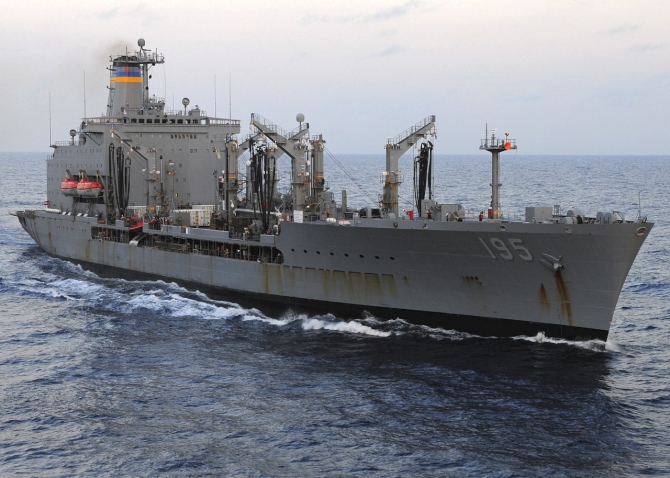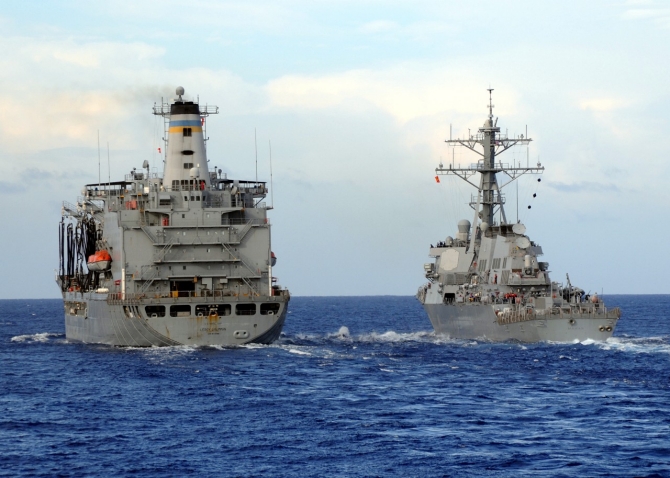Leroy Grumman (T-AO-195)
1989–
U.S. Navy ship named in honor of Leroy Randle Grumman, a prominent industrialist, aeronautical engineer and test pilot. Born in Huntington, New York on 4 January 1895, he demonstrated an interest in aviation at an early age. Grumman went on to earn a Bachelor of Science degree in mechanical engineering from Cornell University in 1916. He began his first job in the engineering department of the New York Telephone Company. After the United States entered World War I, he enlisted in the U.S. Navy Reserve in June 1917 as a machinist's mate 2nd class and was assigned to Columbia University for a course on engines.
Although Grumman applied for flight training, he failed a medical evaluation when the examining board diagnosed flat feet. However, due to a clerical error, he was ordered to report to a course in aircraft inspection for pilot trainees at the Massachusetts Institute of Technology (MIT). He entered primary flight training at Naval Air Station (NAS) Miami, Fla. and successfully completed advanced flight training in Pensacola, Fla. in September 1918. He was commissioned an ensign as naval aviator 1216 and became a bomb squadron flight instructor.
Afterwards, the Navy once again ordered him to MIT. Grumman’s course of study was the new discipline of aeronautical engineering. After completing the course, his first assignment, along with a promotion to lieutenant, was at the League Island Navy Yard as an acceptance test pilot for Curtiss flying boats.
In 1919, the U.S. Navy stationed Grumman at Loening Aeronautical Engineering Corporation in New York City as the project engineer to supervise the firm's construction of 52 Loening M-8 monoplane observation/fighter aircraft under contract to the Navy. His duties included test flying as well as serving as the production supervisor. Grover Loening, the company president, was so impressed with his work that he offered Grumman a position. After a reduction in rank to ensign in the peacetime Navy, Grumman took him up on his offer. He resigned his commission in October 1920 and became a test pilot flying various types of Loening amphibians while doing some design and development on these aircraft. He quickly moved up in the Loening organization, becoming the factory manager and then general manager with responsibility over aircraft design, a position he held until the company was sold in 1929 to Keystone Aircraft.
Grumman joined fellow Loening employees Jake Swirbul and William Schwendler in forming their own company, Grumman Aeronautical Engineering Co. The co-founders were soon joined by Ed Poor, Grover Loening's business manager, and E. Clinton Towl, who had recently come from Wall Street. These five men formed the company's inner circle of management for the next 50 years. Loening and his brother, Albert P. Loening, also became investors.
On 2 January 1930, the company took possession of an abandoned auto showroom garage in Baldwin, N.Y. that had once been the Cox-Klemin Aircraft Co. factory. Initially, the new company, with only 18 employees on salary, had contracts to repair damaged Loening amphibians and traded on its expertise in working with aluminum by building aluminum floats and producing truck bodies.
Grumman was awarded a patent for retractable landing gear in 1932, based on an earlier design that he had developed for the Loening Air Yacht. The innovative design helped his company win contracts from the Navy. When the Grumman Company received its first Navy production contract for a two-seater biplane fighter, the FF-1, it featured Grumman's trademark landing gear. He also single-handedly invented a folding wing system that revolutionized carrier aircraft storage and handling. Although Grumman realized the importance of his close relationship with the Navy, he began to design aircraft for the commercial market with the development of the G-21 Goose amphibian and the G-22 Gulfhawk, civil version of the Grumman F3F carrier-based fighter.
By 1939, as World War II began erupting in Europe, Grumman's company obtained important civil and military contracts. However, by 1940 there were dramatic changes in the company's fortunes as the conflict prompted France and Britain to order F4F Wildcats, Grumman's first monoplane fighter design, still bearing his original signature design element, retractable landing gear.
Beginning with the Wildcat and then with the F6F Hellcat fighters, Grumman and Swirbul remained the key figures in the design office. As the war progressed, the pair continued to advance new projects, including the largest single-engine aircraft of World War II, the TBF Avenger torpedo bomber, F7F Tigercat and F8F Bearcat fighter aircraft.
By March 1945, Grumman oversaw a production effort where all types reached a record 664 aircraft manufactured in one month. Like its competitors, Grumman Aircraft Engineering Corporation experienced severe postwar downsizing, dropping from 20,500 to 5,400 employees immediately after the cessation of hostilities. Grumman stepped down from the role of president of the company in 1946, but continued to play an active role in management.
Grumman restructured the company and solidified its long-term contacts with the Navy, beginning a continuous line of new combat aircraft. Grumman's first venture into jet aircraft, the F9F Panther, became operational in 1949, although the company's most significant postwar successes came in the 1960s with the A-6 Intruder and in the 1970s with the F-14 Tomcat.
He successfully guided the company into finding new markets for its products. In a move towards diversification, he again entered the commercial civil aviation market, introducing landmark designs such as the Ag Cat aerial application and crop-dusting biplane and the Gulfstream series of executive turboprop and jet transport.
While continuing the company tradition of aircraft production for naval aviation, Grumman pushed for a shift in priorities resulting in the Space Steering Group, a space program that culminated in the design and production of the Apollo program’s lunar excursion module that landed astronauts on the moon in 1969. During that same year, the company was rebranded as Grumman Aerospace Corp.
On 19 May 1966, Grumman retired as chairman, but was elected honorary chairman for his lifetime, remaining as a director until 15 June 1972. He passed away on 4 October 1982 at the age of 87.
(T-AO-195: displacement 9,500; length 677'; beam 97'; draft 35'; speed 20 knots; complement 103; armament 1 .50-caliber machine gun, 2 20 millimeter Phalanx close in weapon systems (CIWS); class Henry J. Kaiser)
Leroy Grumman was laid down on 6 July 1987 at New Orleans, La., by Avondale Shipyard, Inc.; launched on 3 December 1988; and co-sponsored by Mrs. Marion Grumman Phillips, Ms. Florence Grumman Hold and Mrs. Grace Grumman Nelson, daughters of the late Leroy Grumman. She entered non-commissioned U.S. Navy service under the control of the Military Sealift Command (MSC) with a primarily civilian crew on 3 August 1989. She serves in the United States Atlantic Fleet.


Leroy Grumman participated in exercise Joint Warrior 10-1 from 10-23 April 2010. Joint Warrior was a United Kingdom-led, multi-warfare exercise designed to improve interoperability between allied navies and prepare participating crews to conduct combined operations during deployment. The exercise also promoted Commander, U.S. 2nd Fleet's three focus areas: conducting safe and effective fleet operations to achieve mission, providing ready maritime forces for global assignment and teaming with allies and partners in execution of the maritime strategy.
Joint Warrior allowed DESRON 24, commanded by Capt. Aaron C. Jacobs, commodore, and British ships to work together with maritime, land and air units from allied nations while providing each other with key services and logistical support. The participating ships were divided into units that represented fictional regions that were having territory disputes. Scenarios the ships participated in included small boat attacks, boarding operations, air defense, anti-submarine warfare and ship maneuverability tasks.
Joint Warrior served as a certifying event for ships that were to deploy with coalition forces in the future. Nations participating in the exercise were Belgium, Brazil, France, Germany, Italy, Netherlands, New Zealand, United Kingdom and the United States.
On 30 January 2015, BAE Systems Norfolk Ship Repair, Norfolk, Va., was awarded a $6,976,389 firm-fixed-price contract for 43 day shipyard availability for the Mid Term Availability of Leroy Grumman. Work included cleaning and gas freeing tanks, voids, cofferdams and spaces, steel RAS (Replenishment At Sea) and FAS (Fuel At Sea) Kingpost Brackets, miscellaneous steel & 01 Level Expansion Joint, ultrasonic thickness hull, port and starboard main engine 12k overhaul, Marine Sanitation Device system flush, replacing the steering differential box and saddle winch and motor overhauls.
Detailed history pending.
Paul J. Marcello
7 December 2015


